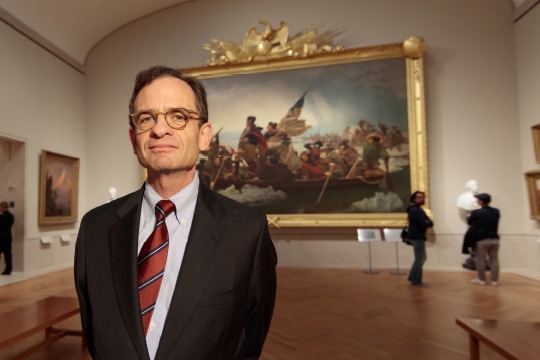My Friday post about staff shrinkage, from buyouts, at the Metropolitan Museum of Art* set off quite a stir: Emergency meetings were held inside the museum to discuss what was going on and the press office ramped up to get information and interview opportunities to various news outlets with Daniel Weiss (pictured), the Met’s president, and Thomas P. Campbell, the director. In that order, which itself says something.
 The upshot, as I predicted, is that not enough people took voluntary buyouts to achieve the necessary cost savings and that therefore there will be involuntary layoffs, starting in the fall. And who would that entail? Weiss gave The Wall Street Journal the most interesting statement: “Nobody is ruled out.”
The upshot, as I predicted, is that not enough people took voluntary buyouts to achieve the necessary cost savings and that therefore there will be involuntary layoffs, starting in the fall. And who would that entail? Weiss gave The Wall Street Journal the most interesting statement: “Nobody is ruled out.”
That is a good thing, probably. Buyouts were available only to those aged 55 and over who had at least 15 years of experience at the museum. Some 56 people signed up, and with them goes a lot of expertise and institutional memory. Some departments, notably technology, apparently escaped unscathed because they have few to no people with 15 years of experience, and these departments will have to slim down, too. The Met is seeking to trim at least 100 people, all told, from its payroll (though some will clearly have to be replaced).
The “nobody” quote, however, raises questions. IÂ presume, for now, that the Met will not fire Campbell (trust me, for a bit). Certainly not as part of the layoffs.
But my sources have frequently mentioned that Sheena Wagstaff, whom Campbell hired in 2012 as chair of the department of modern and contemporary art, is vulnerable. For one, few people consider the Breuer building to be a rousing success. Many have noted that attendance is often mimimal–sometimes the galleries are nearly empty–though the museum told The New York Times  that attendance (185,000 in the first four months) had exceeded its target (155,000).
(That, btw, would make an annual target of just 465,000 people–which is smack in the middle of the Whitney’s experience there. In the late ’90s, the Whitney attracted 650,000 to 670,000 visitors a year, but by the time it announced its move downtown, that had slipped (in 2009) to 322,000.)
The new Diane Arbus show may change that, but it’s a photography show–different department from Wagstaff’s. Maybe the Kerry James Marshall exhibition, which opens in October, will help. Interestingly, the Met in early July changed the Breuer building hours, adding Saturday, and forgoing Thursday, as one of the two nights it is open until 9 p.m., along with Friday–just like the Fifth Avenue building.
But back to Wagstaff: if people are unhappy with her leadership–and they are–she, I’m told, isn’t a happy camper at the Met either. Her husband still lives in London and a A daughter who wanted to live here, near her, could not extend her necessary work permit. UPDATE: Wagstaff’s husband, Mark Francis, now informs me that he lives in New York now. My apologies for using old information.
I’m sure Wagstaff is well paid, but she is not listed on the Met’s tax return as among the highest paid employees either.
On that list for the year ended June 30, 2015, ten of the 20 have already departed or are in the current buyout class. (I am excluding Campbell and Emily Rafferty, Weiss’s predecessor, from the number: They would bring the total to 22–but the percentage gone is the same, as Rafferty left last year, too.)
Let’s keep some perspective, here: 100 cuts from a 2,300-strong workforce is not devastating, in and of itself. It all depends on which people are going.
It was worrisome, though, that Campbell said exhibitions would be cut to 40 per year from 55 to reduce costs. That’s more than a quarter.
Photo Credit: Courtesy of GW Magazine
*I consult to a foundation that supports the Met.
